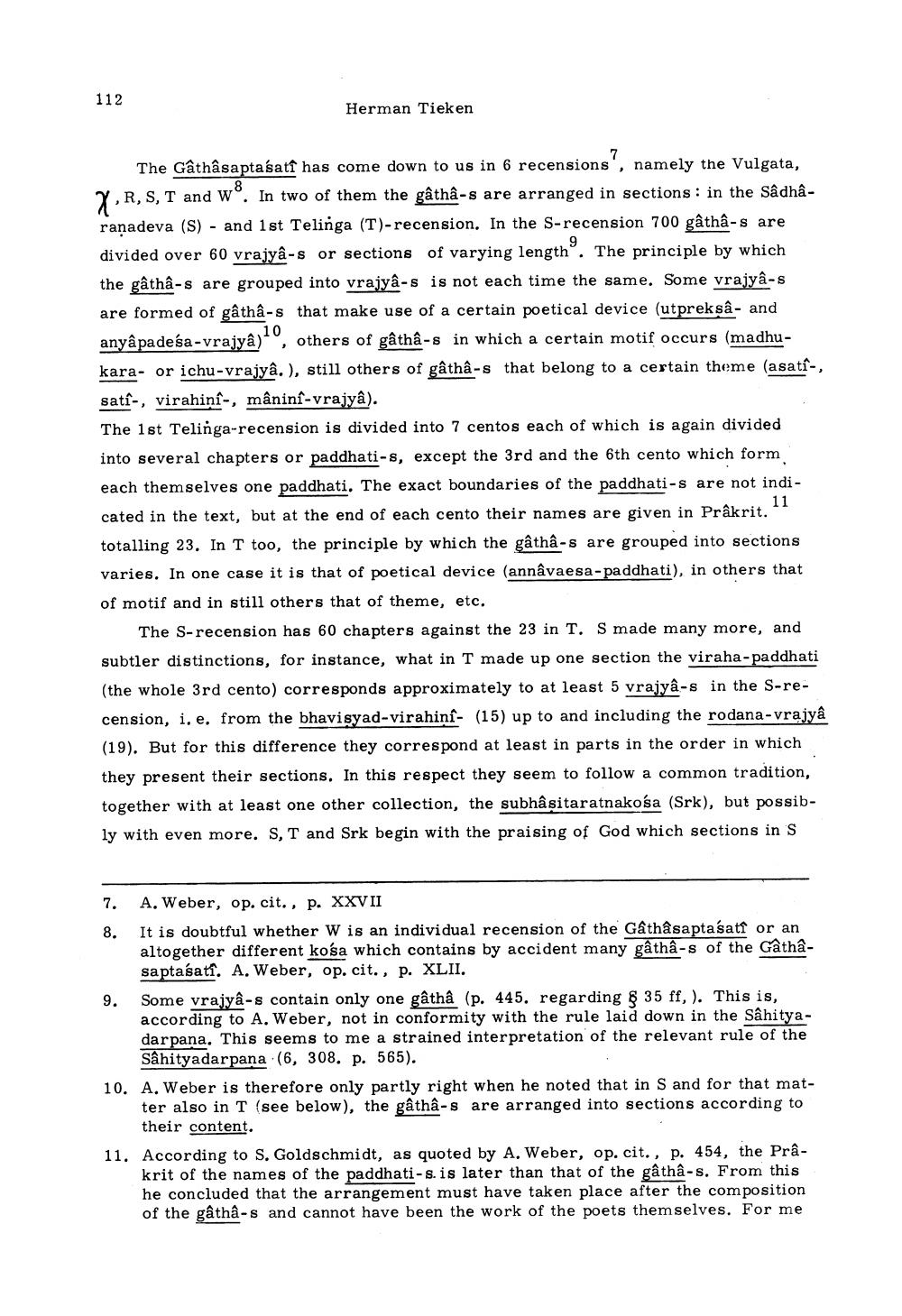Book Title: Studien Zur Indologie Und Iranistik Author(s): Gert Klingenschmitt, Albrecht Wezler, Michael Witzel Publisher: Gert Klingenschmitt, Albrecht Wezler, Michael Witzel View full book textPage 3
________________ 112 Herman Tieken The Gâthâsaptasatt has come down to us in 6 recensions', namely the Vulgata, 7, R, S, T and Wo. In two of them the gâthâ-s are arranged in sections: in the Sâdhâranadeva (S) - and 1st Telinga (T)-recension. In the S-recension 700 gâthâ-s are divided over 60 vrajyâ-s or sections of varying length. The principle by which the gâthâ-s are grouped into vrajyâ-s is not each time the same. Some vrajyâ-s are formed of gâthâ-s that make use of a certain poetical device (utprek sâ- and anyâpadeśa-vrajya)'', others of gâthâ-s in which a certain motif occurs (madhukara- or ichu-vrajyâ. ), still others of gâthâ-s that belong to a certain theme (asati-, satî-, virahinî-, mâninf-vrajyâ). The 1st Telinga-recension is divided into 7 centos each of which is again divided into several chapters or paddhati-s, except the 3rd and the 6th cento which form each themselves one paddhati. The exact boundaries of the paddhati-s are not indicated in the text, but at the end of each cento their names are given in Prâkrit." totalling 23. In T too, the principle by which the gâthâ-s are grouped into sections varies. In one case it is that of poetical device (annâvaesa-paddhati), in others that of motif and in still others that of theme, etc. The S-recension has 60 chapters against the 23 in T. S made many more, and subtler distinctions, for instance, what in T made up one section the viraha-paddhati (the whole 3rd cento) corresponds approximately to at least 5 vrajyâ-s in the S-recension, i.e. from the bhavisyad-virahin- (15) up to and including the rodana-vrajya (19). But for this difference they correspond at least in parts in the order in which they present their sections. In this respect they seem to follow a common tradition, together with at least one other collection, the subhâsitaratnakosa (Srk), but possibly with even more. S, T and Srk begin with the praising of God which sections in S 8. 7. A. Weber, op. cit., p. XXVII It is doubtful whether W is an individual recension of the Gâthâsaptasatt or an altogether different kośa which contains by accident many gâthâ-s of the Gathasaptaśati. A. Weber, op. cit., p. XLII. Some vrajyâ-s contain only one gâthâ (p. 445. regarding & 35 ff, ). This is, according to A. Weber, not in conformity with the rule laid down in the Sahityadarpana. This seems to me a strained interpretation of the relevant rule of the Sâhityadarpana (6, 308. p. 565). 10. A. Weber is therefore only partly right when he noted that in S and for that mat ter also in T (see below), the gâthâ-s are arranged into sections according to their content. According to S. Goldschmidt, as quoted by A. Weber, op. cit., p. 454, the Prâkrit of the names of the paddhati - s. is later than that of the gâthâ-s. From this he concluded that the arrangement must have taken place after the composition of the gâthâ-s and cannot have been the work of the poets themselves. For mePage Navigation
1 2 3 4 5 6 7 8 9 10 11 12 13 14 15 16 17 18 19 20 21 22
